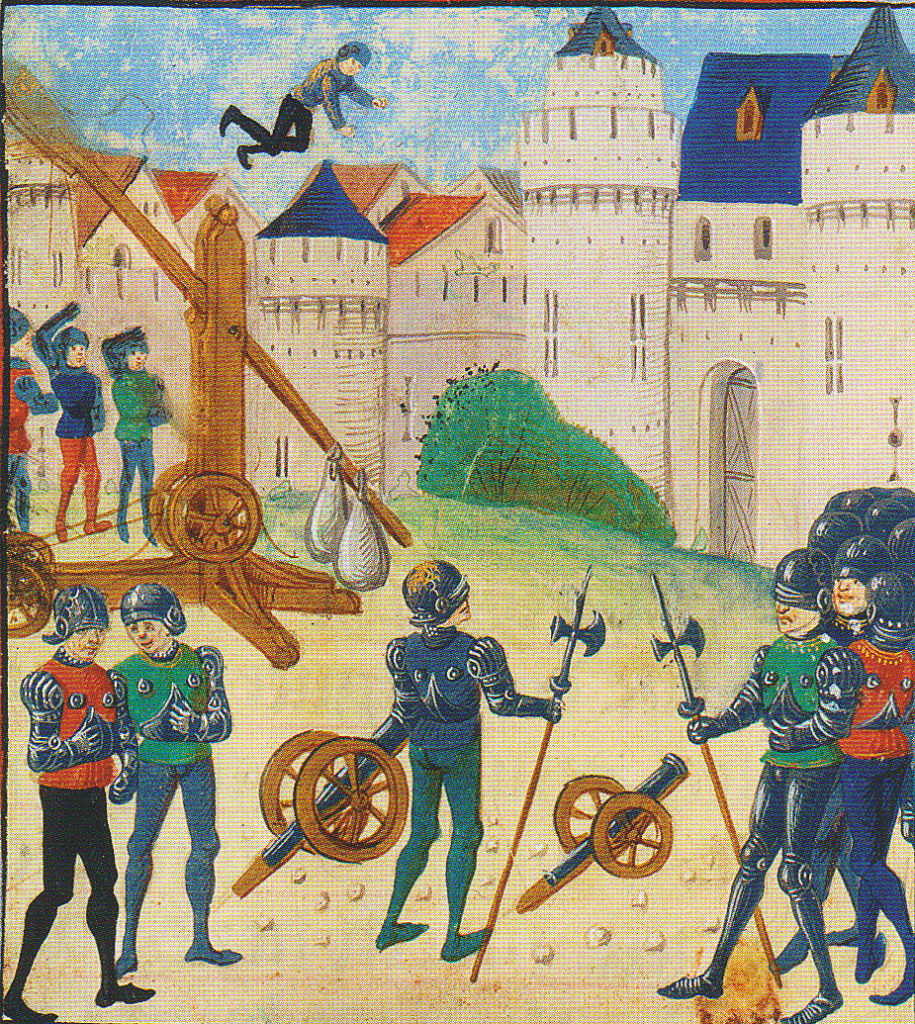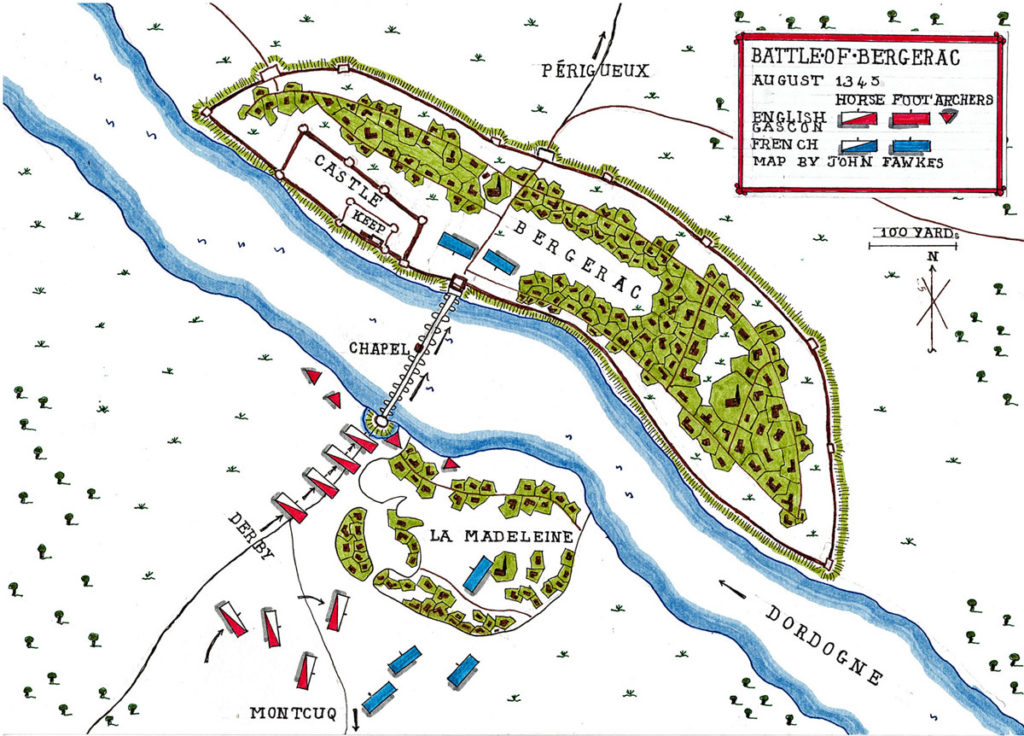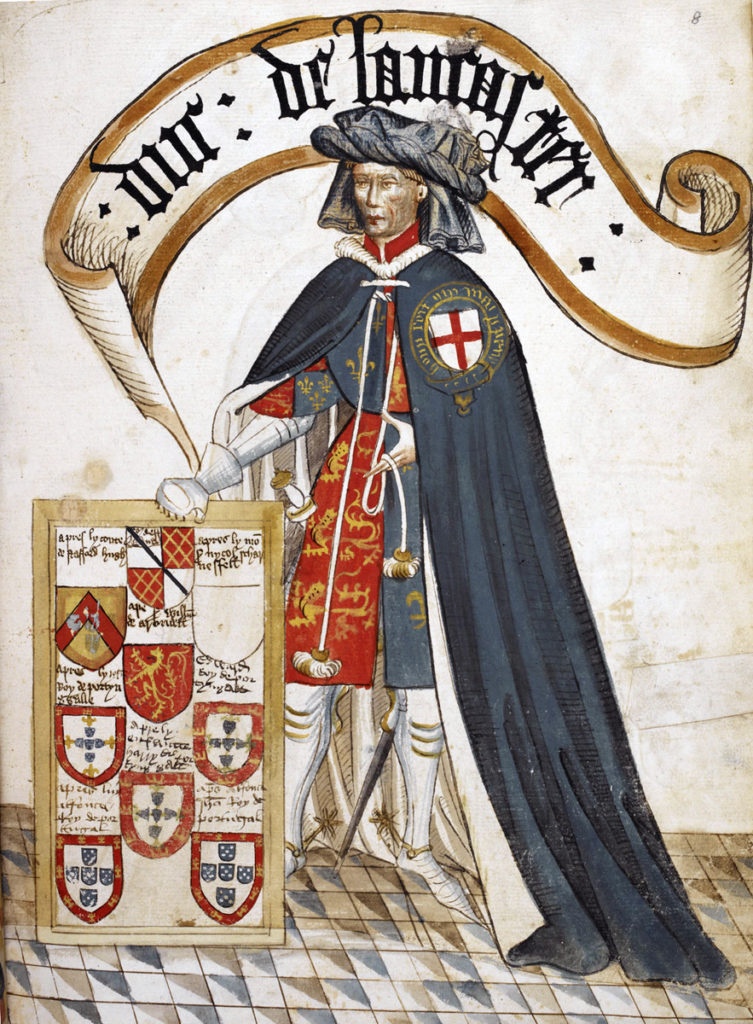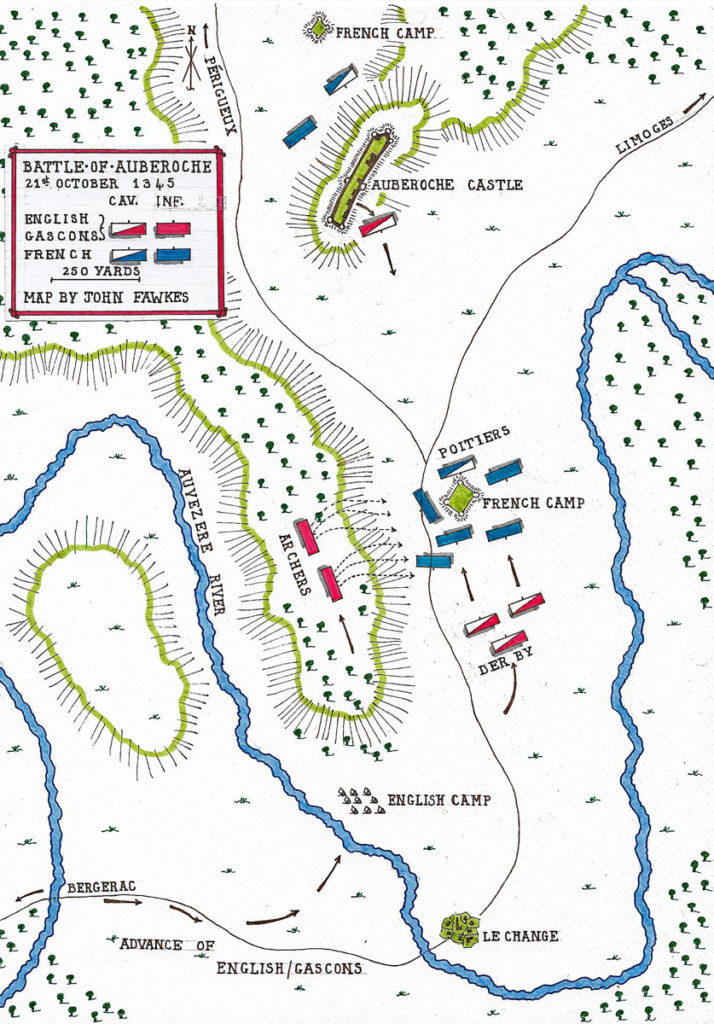The battle in Périgord in France fought on 21st October 1345 during the Hundred Years War where a small English/Gascon army defeated a French army six times its size

The previous battle of the Hundred Years War is the Battle of Morlaix
The next battle of the Hundred Years War is the Battle of Caen
Date of the Battle of Auberoche: 21st October 1345
Place of the Battle of Auberoche: in Périgordin western France.
Combatants at the Battle of Auberoche: An English/Gascon army against a French army.
Commanders at the Battle of Auberoche: The Earl of Derby, later Duke of Lancaster, commanded the English/Gascon force. Louis of Poitiers and the Count de L’Isle commanded the French army.
Size of the armies at the Battle of Auberoche: The English force comprised 400 men-at-arms and 800 archers. The French army comprised around 7,000 men-at-arms, crossbowmen and peasant infantry. The English garrison in Auberoche numbered around 150 men-at-arms and archers.
Winner of the Battle of Auberoche: The French force was driven from the battlefield with substantial casualties and the siege of Auberoche Castle lifted.
Background to the Battle of Auberoche:
on 9th August 1344 an English army led by Henry of Lancaster, Earl of Derby, arrived in Bordeaux on the French Atlantic coast with instructions from King Edward III of England to halt the French invasion of Edward’s dukedom of Aquitaine (Gascony) and retake the ground captured by the French over the previous years.
Derby abandoned the strategy of the English commander that he succeeded, the Earl of Stafford, of methodically besieging and capturing the castles held for the French Crown and marched up the River Dordogne to Liborne, where he joined forces with Stafford’s army before marching east to take the important town of Bergerac on the Dordogne River, relieving the besieged castle of Montcuq on the way.
Bergerac was the principal French garrison town in the south of Périgord, with a fortified stone bridge providing the major crossing point over the Dordogne River into Périgord.
Derby’s army marched hard and fast to the castle of Montcuq, to the south of Bergerac, catching the French besiegers by surprise and causing them to retreat precipitously to La Madeleine, the village on the opposite bank of the Dordogne from Bergerac, abandoning their siege equipment in their haste.

Capture of Bergerac:
The French army was passing onto the Bergerac bridge when Derby’s army entered La Madeleine.
English men-at-arms delivered a mounted charge across the bridge, while the English archers moved onto the sandbank jutting into the river and fired volleys of arrows at the French column.
Closely following the escaping French, the English men-at-arms forced the portcullis at the northern end of the bridge, jammed open by a wounded horse and stormed into Bergerac.
The French army, led by the Count of Armagnac, fled the town and made for the city of Périgueux, the regional capital of Périgord.
The French troops cut off in La Madeleine escaped to the south and rallied in the town of La Reole, under the command of the Count de L’Isle.
Battle of Auberoche:
The shock to the French of the unexpected loss of Bergerac caused Philip VI, King of France, to divert substantial military resources to Gascony.
A large French army assembled under the command of the Duke of Normandy, with troops from several areas of the south of France.
By mid-October 1345, the Earl of Derby laid siege to Périgueux, the relief of which became a priority for the French.
Part of the French army, led by Louis of Poitiers, advanced on Périgueux, causing Derby’s heavily outnumbered force to fall back to Liborne, 15 miles east of Bordeaux on the Dordogne River.
With Périgueux secured, Louis of Poitiers began the process of capturing the castles held by English/Gascon garrisons in the vicinity of the city.
To the north-east of Périgueux lay the powerful fortress of Auberoche, commanded by Alexander de Caumont, an experienced Gascon soldier.
In early October 1345, Louis of Poitiers laid siege to Auberoche.
The garrison sent word to the Earl of Derby that it was under attack.
The Earl of Derby assembled a force in Liborne and sent word to the Earl of Pembroke to join him with the troops under his command for an advance to relieve Auberoche.
Derby awaited Pembroke’s arrival for a day, then set off on the march to Auberoche, leaving instructions for Pembroke to follow.
Derby reached Bergerac and waited briefly for Pembroke, before continuing directly across country to Auberoche.
Auberoche Castle stood on a crag overlooking the River Auverzere, a southern tributary of the Dordogne River.
Part of the besieging French army held a small camp on the north side of the castle.
The main French force occupied a camp on the southern side of the castle on the bank of the River Auverzere.
Derby approached from the west, unseen by the French, crossed the loop of the river and halted to the north of the village of Le Change on the evening of 20th October 1345, where his troops made camp.
Strict instructions prevented the soldiers from straying from the camp to prevent the French becoming aware of the arrival of the English/Gascon army.
A final message was sent to Pembroke giving him the position of Derby’s force.
On 21st October 1345 there was still no sign of Pembroke.
At the end of the morning Derby summoned a council of war.
It was resolved not to wait for Pembroke’s reinforcements, but to attack the French in spite of the substantial inequality in numbers between the two sides; the English/Gascons having some 1,200 men against around 7,000 French troops.
Derby carried out a reconnaissance, creeping through the woods to within a few hundred yards of the French camp.
It was apparent that the French were unaware of the threat from the English force, with no precautions against an attack on the side of their camp away from the castle.
Derby directed his archers to make their way through the woods to where they could fire straight into the western side of the French camp, while his mounted men-at-arms launched a charge into the camp from the south.
Derby would give the signal for the attack with his battle-cry ‘Derby-Guienne’.
The assault was launched, taking the French by surprise, many without their armour or weapons.
As they hurried from their tents the French were shot by the English archers firing from the edge of the wood or cut down by the charging English and Gascon men-at-arms.
The noise and signs of battle were observed from Auberoche Castle, where the commander, Alexander de Caumont, mounted his men-at-arms and led them in a charge on the French rear, while his archers discharged arrows into the French camp from the battlements.
The combination of the two attacks, from front and rear, caused the French army to break and flee the battlefield.
The French troops in the smaller northern camp hastily retreated, without taking any part in the struggle.
Casualties at the Battle of Auberoche:
The French suffered high casualties, substantially during the pursuit.
The French commander, Louis of Poitiers, was wounded and captured, but died soon after the battle. Among the French prisoners were the Comte de L’Isle, another count, seven viscounts, three barons, the nephew of Pope Clement VI and an unrecorded number of knights.
French soldiers of lesser social status were put to the sword.
Follow-up to the Battle of Auberoche:
The defeat at Auberoche caused the French to abandon their plans to besiege and capture a swathe of castles held by the Gascons and English. The Duke of Normandy, although near to the scene of the battle with an army larger than the one defeated in the battle, took no further offensive action, leading his army back to Angoulême and disbanding it in November 1345.
The Battle of Auberoche went far in establishing the reputation of the Anglo/Gascons as invincible in battle.
Anecdotes and traditions from the Battle of Auberoche:
- After the Battle of Auberoche, the Earl of Derby held a dinner in the castle at which the more notable French prisoners were guests. The Earl of Pembroke arrived during the dinner and was also invited.
- A feature of the successful battles at Bergerac and Auberoche was the amount of money made by the English and Gascons from the ransoms they received for the release of the captured French knights and nobles. The Earl of Derby is said to have recovered sufficient money from the Bergerac ransoms to pay for the re-building of his palace at the Savoy in London. His receipts from ransoms after Auberoche were around three times as much.
- Froissart reported that the messenger sent by the garrison of Auberoche Castle to inform the Earl of Derby that the castle was under siege was caught by the French and fired back into the castle using a siege catapult. The man is said to have been severely injured but to have survived the experience. The message still found its way to the Earl of Derby.
References for the Battle of Auberoche:
The Hundred Years War by Alfred H. Burne
Trial by Battle, Volume I of the four volume record of the Hundred Years War by Jonathan Sumption.
The Art of War in the Middle Ages Volume Two by Sir Charles Oman.
The Hundred Years War by Robin Neillands.
British Battles by Grant.
The previous battle of the Hundred Years War is the Battle of Morlaix
The next battle of the Hundred Years War is the Battle of Caen

